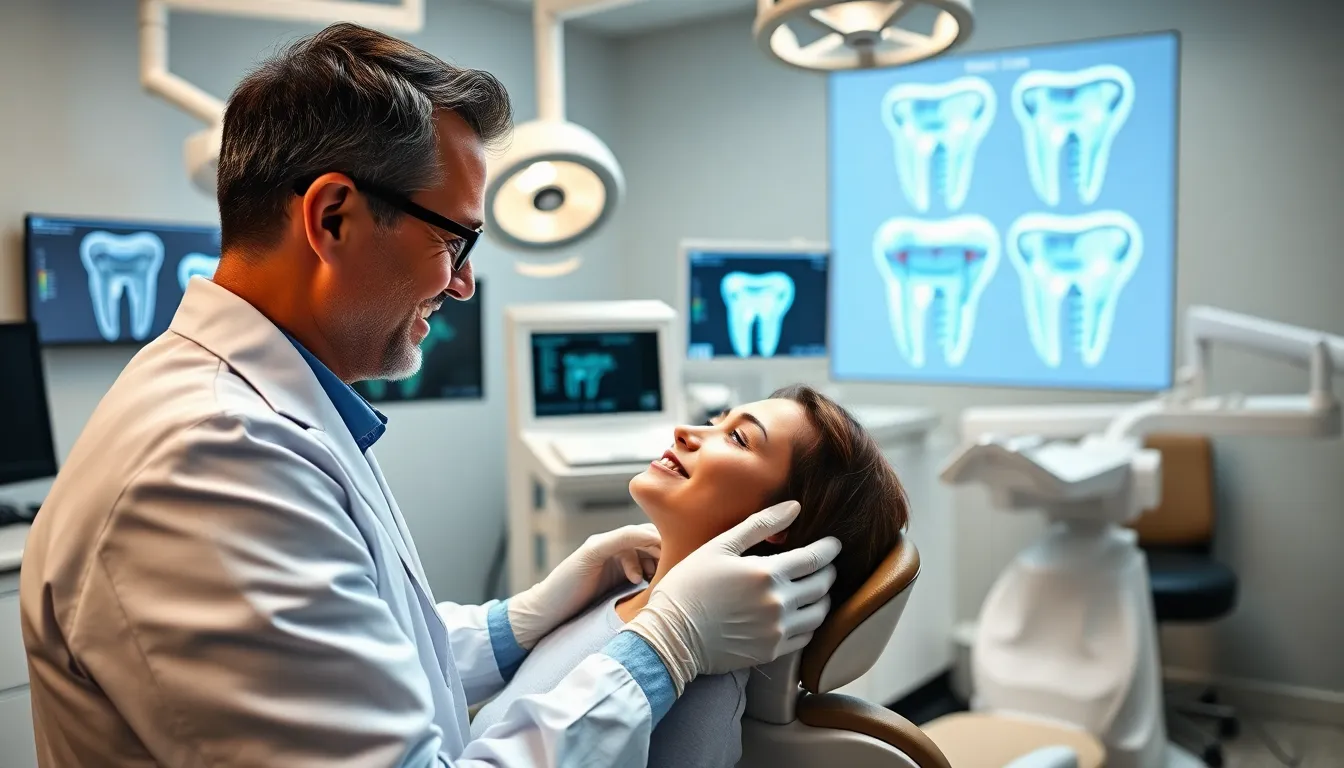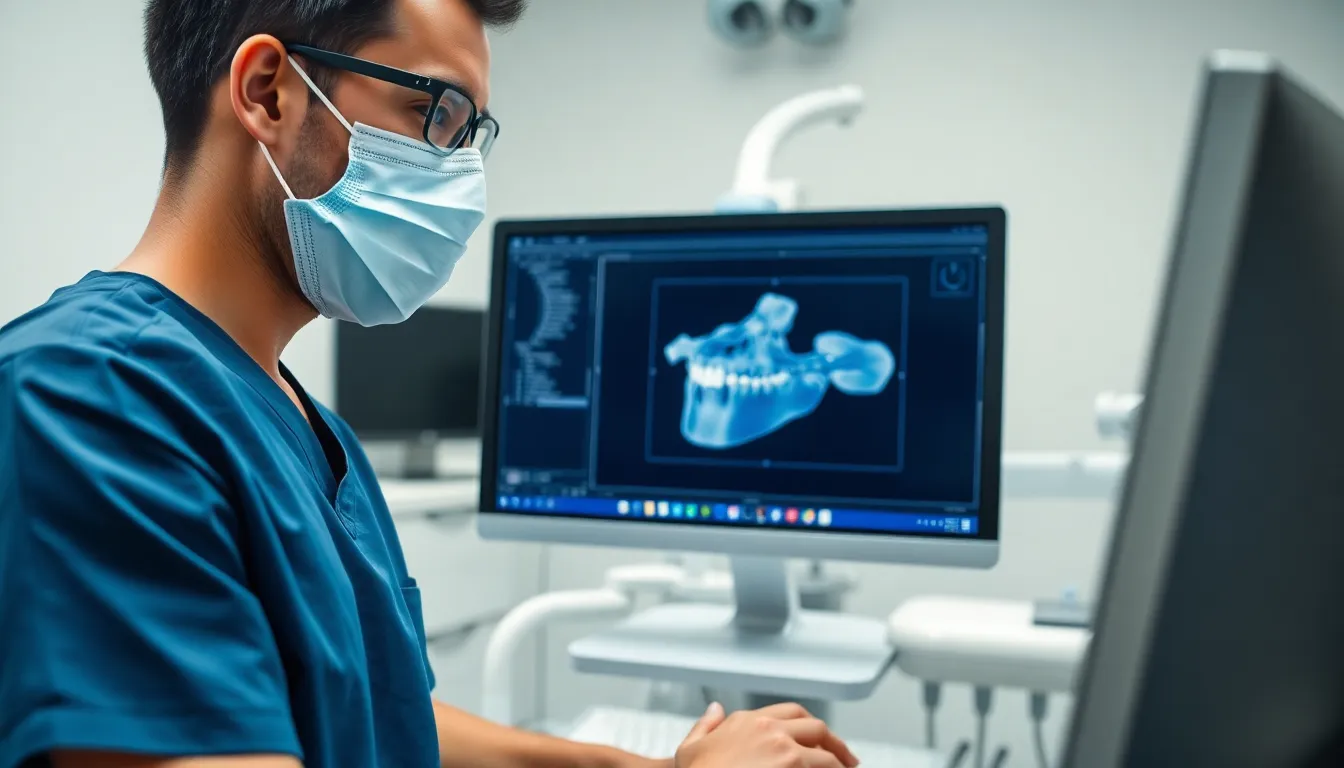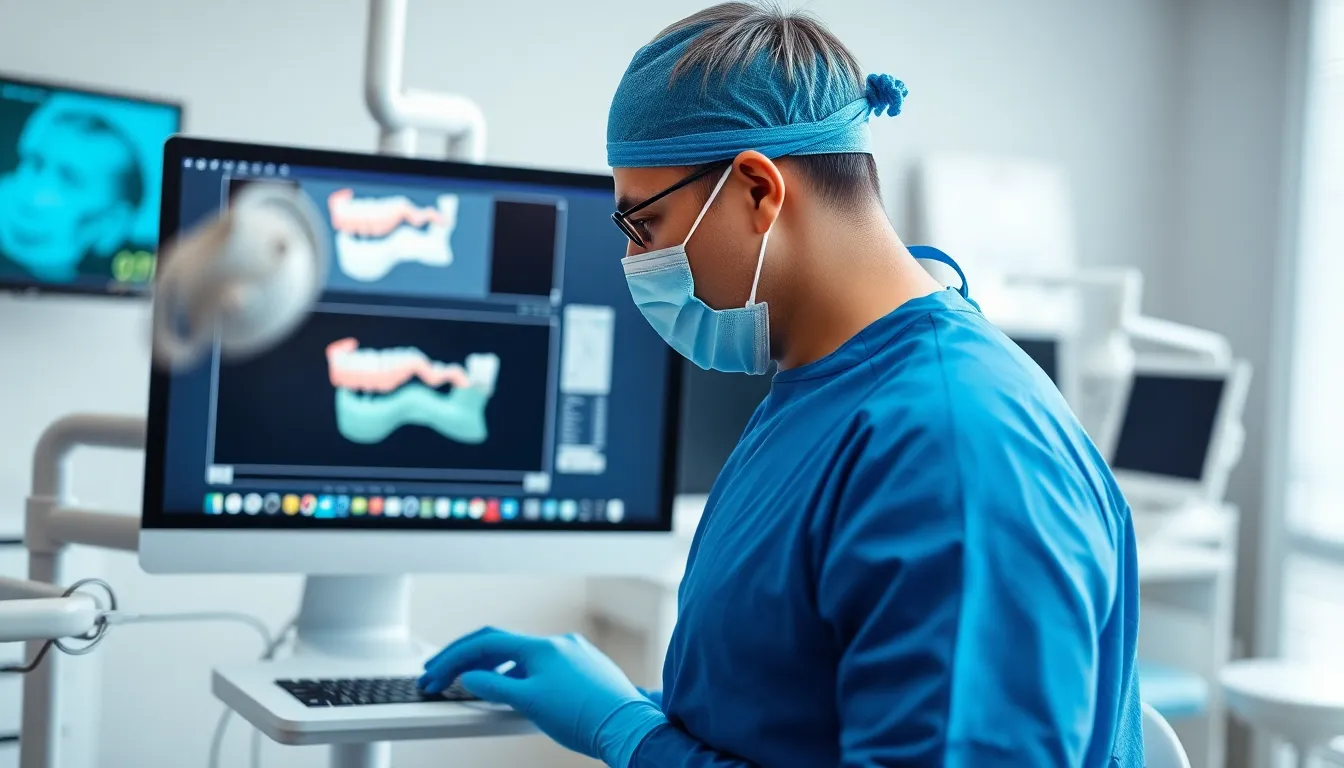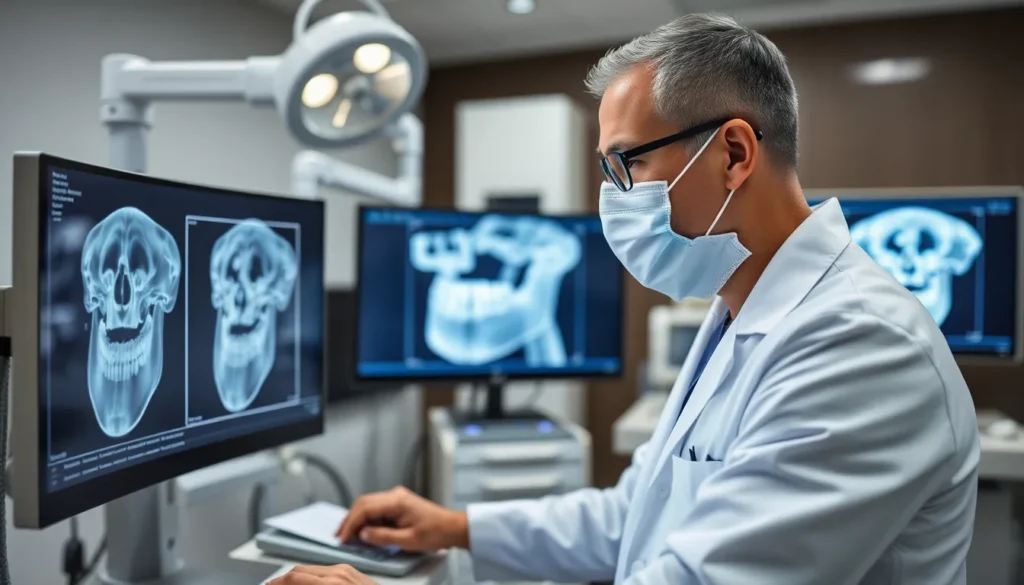Considering guided surgery dental implants? You’re not alone. This revolutionary approach has transformed the way dental professionals place implants, offering precision that traditional methods simply can’t match.
When you’re facing tooth loss, the overwhelming options can make decisions difficult. Guided surgery uses advanced 3D imaging and computer planning to create a precise surgical guide for implant placement. This technology eliminates guesswork, reduces recovery time, and dramatically improves outcomes. The result? A perfectly positioned implant that looks, feels, and functions just like your natural teeth.
What Is Guided Surgery for Dental Implants?
Guided surgery for dental implants combines advanced 3D imaging technology with precision computer planning to create customized surgical guides for implant placement. This innovative approach transforms the traditional implant procedure into a more predictable, accurate, and comfortable experience for patients seeking tooth replacement answers.
The Evolution of Implant Placement Techniques
Dental implant techniques have undergone remarkable transformation over the past several decades. Traditional freehand methods relied heavily on the surgeon’s expertise and visual assessment during the procedure. Digital technology integration marked a important turning point in the early 2000s, introducing computed tomography (CT) scans that allowed practitioners to view bone structures in three dimensions before surgery. Modern guided implant surgery represents the culmination of these advancements, incorporating cone beam CT technology, specialized software for treatment planning, and CAD/CAM fabrication of surgical guides.
Dr. Todd B. Harris often shares the story of a patient named Sarah who had been told she wasn’t a candidate for implants due to limited bone volume. “Using guided surgery technology, we were able to identify precise areas where implants could be successfully placed without grafting. Sarah now enjoys a full set of functional teeth that would have been impossible with conventional approaches,” notes Dr. Harris.
Key Components of Guided Implant Surgery
Guided implant surgery consists of several essential elements working together to ensure optimal results. The process begins with detailed 3D imaging of your oral structures using cone beam CT scans that capture bone density, nerve locations, and anatomical features with sub-millimeter accuracy. Specialized planning software then allows dentists to virtually place implants in ideal positions, considering factors like bone quality, angle of insertion, and prosthetic requirements.
Custom surgical guides created from these digital plans serve as physical templates during surgery, containing metal sleeves that direct the exact position, angle, and depth of each implant. Digital wax-ups provide visualization of the final restoration, ensuring the implants align perfectly with your planned prosthetics. The integration of these components creates a workflow that enhances precision while reducing surgical time and patient discomfort.
Benefits of Guided Surgery in Dental Implantology

Guided surgery has revolutionized dental implantology by offering important advantages over traditional implant placement methods. These benefits directly impact both clinical outcomes and patient experience, making it an increasingly preferred option among dental professionals and patients alike.
Precision and Accuracy Advantages
Guided implant surgery delivers exceptional placement accuracy, positioning implants within 2mm of the planned location through 3D digital planning and surgical guides. Your implants are positioned at optimal angles and depths with guided techniques, helping avoid critical anatomical structures that might be damaged during freehand procedures. Clinical studies demonstrate guided surgery achieves significantly lower failure rates (2.25%) compared to non-guided approaches (6.42%), translating to higher long-term implant survival rates.
Dr. Todd B. Harris explains, “The precision we achieve with guided surgery simply isn’t possible with traditional methods. I’ve seen countless cases where this technology allowed us to place implants in patients who were previously told they weren’t candidates due to anatomical limitations.”
Reduced Surgical Time and Patient Comfort
Surgical time decreases dramatically with guided implant procedures, reducing your time in the dental chair and improving overall comfort. The pre-planned nature of guided surgery often enables a minimally invasive, flapless approach where your gums don’t need to be cut open, resulting in less bleeding, swelling, and post-operative discomfort. Patients experience reduced pain, fewer sutures, faster healing times, and a more comfortable recovery period overall.
Sarah, a recent guided implant patient, shared, “I was amazed at how quick and comfortable the procedure was. I had minimal swelling afterward, and was back to my normal routine much faster than I expected. The precision of the placement means my implant feels just like my natural tooth.”
Additional benefits include more predictable outcomes through meticulous pre-operative planning, customized treatment plans customized to your unique anatomy, and reduced anxiety due to the efficiency and control of the procedure. These advantages combine to make guided dental implant surgery a superior approach that delivers reliable, high-quality results.
The Guided Surgery Dental Implant Process

Guided surgery dental implant is a precise technique that uses digital planning and customized surgical guides to place dental implants with exceptional accuracy. This advanced approach follows a systematic workflow that ensures optimal implant positioning and successful outcomes.
Digital Planning and Treatment Workflow
Digital planning forms the foundation of guided implant surgery success. Your treatment begins with a comprehensive diagnostic appointment where your dentist evaluates your oral condition to determine if you’re a candidate for implants. A cone-beam computed tomography (CBCT) scan captures detailed 3D images of your jawbone and surrounding structures, providing crucial visualization for proper implant planning. Specialized computer software allows your dentist to analyze these digital scans and create a precise surgical plan based on your unique bone density and anatomy.
Dr. Todd B. Harris notes, “The digital planning phase is where the real magic happens. We can visualize potential challenges before they arise and design answers that ensure optimal implant placement for each patient’s unique anatomy.”
This technology enables your dental team to:
- Evaluate bone volume and quality accurately
- Plan implant size, position, and angulation with precision
- Avoid vital structures like nerves and sinuses
- Design a surgical guide that transfers the plan flawlessly to surgery
One patient, Michael, came to our practice after being told by several dentists that his limited bone volume made him a poor candidate for implants. Using our advanced digital planning workflow, we identified exact angles and positions where implants could be successfully placed even though his anatomical limitations. Today, Michael enjoys fully functional implants that have restored both his smile and confidence.
Creating Surgical Guides
Surgical guides translate your digital treatment plan into a physical template that directs the entire implant placement procedure. These computer-designed guides are typically fabricated through 3D printing and incorporate the exact locations and angulations needed for precise implant drilling and placement. Your custom surgical guide fits perfectly in your mouth, ensuring that implants are positioned exactly as planned during the digital phase.
The benefits of using surgical guides include:
- Enhanced implant placement accuracy
- Reduced surgical trauma and chairtime
- Predictable aesthetic and functional outcomes
- Patient-exact customization for optimal results
During your implant placement surgery, your dentist uses the surgical guide to direct the creation of precise implant sites in your jawbone. Titanium implant posts are then positioned according to the predetermined plan. A healing cap protects each site while osseointegration occurs over the next 3-6 months, after which your final restoration is placed.
Technology Behind Guided Implant Surgery

Guided implant surgery harnesses cutting-edge digital technology to revolutionize dental implant placement. This advanced approach combines detailed 3D imaging with sophisticated computer software to create a comprehensive virtual model of your oral anatomy before any surgical intervention occurs.
CBCT Imaging and 3D Software
CBCT imaging captures extraordinarily detailed, three-dimensional views of your jawbone, teeth, nerves, and surrounding tissues with remarkable accuracy. Your dental scan data transfers directly into specialized 3D planning software, allowing your dentist to meticulously plan every aspect of the implant procedure virtually. The software enables precise selection of optimal implant size, angle, and position to maximize success while avoiding vital structures like nerves and sinuses. Dr. Todd B. Harris explains, “With CBCT technology, we can see exactly what’s happening beneath the surface—identifying bone density variations and anatomical landmarks that would be impossible to visualize with traditional x-rays.” This virtual blueprint then translates into a physical surgical guide that fits perfectly in your mouth, directing drills and implant placement with exceptional precision during the actual procedure.
Types of Surgical Guide Systems
Surgical guide systems vary based on support mechanisms and guidance levels, each offering exact advantages for different clinical situations:
- Bone-supported guides rest directly on the jawbone and prove ideal for patients with important gum tissue loss, providing stable positioning during surgery.
- Mucosa-supported guides sit on the gum tissue, making them particularly suitable for edentulous patients who have adequate soft tissue coverage.
- Tooth-supported guides fit over your remaining natural teeth, offering extremely stable positioning for partially edentulous cases.
- Fully guided surgery utilizes guides that control every surgical step from initial drilling through final implant insertion, improving precision and dramatically reducing surgery time.
- Partially guided surgery employs guides for initial drilling only, giving your surgeon discretion during subsequent steps of the procedure.
One of Dr. Harris’s patients, Michael, benefited tremendously from a tooth-supported fully guided system. “Michael had limited space between adjacent teeth, making traditional freehand placement extremely challenging,” notes Dr. Harris. “Using a fully guided approach, we placed his implant within 0.2mm of the planned position, resulting in perfect alignment with surrounding teeth and optimal function.” These advanced guides consistently deliver greater accuracy, reduced surgical invasiveness, shorter recovery times, and significantly lower risk of damaging critical anatomical structures compared to traditional methods.
Clinical Outcomes and Success Rates

Guided dental implant surgery delivers exceptional clinical outcomes with documented success rates that frequently surpass traditional methods. Research confirms the reliability and longevity of implants placed using this advanced technique.
Comparing Guided vs. Freehand Implant Placement
Guided implant placement consistently demonstrates superior accuracy compared to conventional freehand techniques. Comparative studies reveal guided surgery success rates of 98.2% at 6 months and 96.4% at 12 months, outperforming conventional two-stage and immediate placement methods which range from 92% to 96% during the same timeframes. The precision achieved through guided surgery directly impacts these improved outcomes.
“The difference in placement accuracy between guided and freehand techniques is truly remarkable,” notes Dr. Todd B. Harris. “With guided surgery, we’re able to position implants within fractions of a millimeter of the planned location, which simply isn’t possible with traditional approaches.”
The type of surgical guide significantly influences accuracy results. Tooth-supported guides offer the highest precision, making them ideal for patients with remaining natural teeth. Mucosa-supported and bone-supported guides provide excellent alternatives for other clinical situations, though their accuracy metrics may vary slightly.
Lisa, a 52-year-old patient who had previously experienced a failed implant placed using traditional methods, found success with guided surgery. “After my previous experience, I was hesitant to try again,” she shares. “But the guided approach Dr. Harris used gave me confidence, and five years later, my implant feels completely natural.”
Long-Term Survival Statistics
Long-term data confirms the durability of implants placed using guided surgical techniques. While broader literature reports 10-year survival rates exceeding 95% for dental implants generally, exact studies on guided implant surgery show varying results. A notable 10-year follow-up study involving 32 guided implants reported an 81.25% survival rate after nearly 11 years, with marginal bone loss stabilizing after five years.
“What’s particularly encouraging about the long-term data is the stability we see in marginal bone levels after the initial healing period,” Dr. Harris explains. “This indicates that properly placed implants through guided surgery create a sustainable foundation for lasting restorations.”
Fully guided dental implant surgery reduces procedural risks and enhances predictability, maintaining success rates above 95% in many clinical scenarios. The precision of placement minimizes complications that might otherwise compromise long-term outcomes.
A comprehensive analysis of guided surgery outcomes demonstrates favorable long-term results even though some studies showing slightly lower survival rates—potentially influenced by sample size limitations or exact patient selection criteria. The consistent marginal bone preservation observed over extended periods reinforces guided surgery’s value as a reliable approach for implant rehabilitation.
Limitations and Considerations

Guided surgery for dental implants offers important advantages, but it’s essential to understand its limitations and considerations before proceeding with treatment. Several factors can influence the success and suitability of guided implant procedures for your exact case.
Early Failures and Implant Survival
Guided dental implant surgery demonstrates high implant survival rates with fewer complications compared to traditional methods. Most failures stem from lack of osseointegration rather than the guided technique itself. Bone quality, volume, and anatomical constraints remain critical factors affecting outcomes even though the precision of guided assistance. Dr. Harris notes, “Even with the most advanced guided systems, we must carefully evaluate each patient’s bone structure to ensure long-term success.”
One patient, Robert, experienced initial concerns when his implant showed slight mobility six weeks after placement. Upon examination, we discovered his bone density was lower than initially assessed, requiring additional healing time before final restoration. This highlights how individual factors can influence outcomes even with precise guided placement.
Accuracy and Predictability
Guided systems significantly improve accuracy in implant placement compared to freehand surgery. This enhanced precision reduces the risk of damaging vital anatomical structures like nerves and blood vessels. Research demonstrates that guided surgery achieves placement within 1mm of the planned position in most cases. But, the long-term clinical outcomes may be similar to conventional surgery in some scenarios, indicating that guided surgery serves as an additional aid rather than a guarantee of superior results.
Surgical invasiveness is typically reduced with guided techniques, as they often use flapless approaches. This minimally invasive method leads to less bleeding, reduced swelling, and faster recovery times for patients. Mary, a recent implant patient, remarked, “I was surprised by how little discomfort I experienced after my guided implant surgery compared to my previous dental work.”
Cost Factors of Guided Surgery
Guided implant surgery involves additional costs that reflect the advanced technology utilized throughout the process. The investment includes specialized software for virtual planning, fabrication of 3D-printed surgical guides, and potentially longer preoperative planning time. These expenses typically add $500-$1,000 to the overall treatment cost compared to conventional implant procedures.
Dr. Harris explains, “While the initial investment may be higher, patients often benefit from fewer complications, reduced chair time, and more predictable outcomes. These advantages can offset the additional costs by eliminating the need for corrective procedures.” Many practices offer financing options to make guided surgery more accessible, recognizing its long-term value for optimal implant placement.
Learning Curve for Practitioners
Mastering guided implant surgery requires dedicated training to effectively use planning software, understand digital workflows, and accurately apply surgical guides. The learning curve can be steep, as both surgeons and their assistants must develop proficiency to achieve optimal outcomes. Practitioners typically need to complete 10-15 guided cases before becoming fully comfortable with the workflow.
Dr. Harris shares, “When I first implemented guided surgery in my practice, I invested in comprehensive training for my entire team. This preparation was crucial for our success, as proper guide positioning and protocol adherence are essential skills that develop with experience.” Clinicians who lack adequate training may not fully realize the benefits of guided surgery, potentially compromising accuracy and outcomes. Professional development courses and mentorship programs have emerged to support practitioners in building these specialized skills.
Ideal Candidates for Guided Dental Implant Surgery
Guided dental implant surgery offers precise, technology-driven answers for patients seeking tooth replacement. You’re an excellent candidate for this advanced procedure if you have sufficient bone density and no uncontrolled health conditions that might compromise healing or implant integration.
Complex Cases and Multiple Implants
Complex dental scenarios benefit tremendously from guided implant surgery’s 3D digital planning capabilities. Patients requiring multiple implants experience improved surgical outcomes as dentists can visualize exact placement angles and depths for several implants simultaneously. The precision of guided techniques reduces both risk and operative time while ensuring coordinated implant placements.
“I’ve seen remarkable results in patients needing full-arch restoration,” notes Dr. Todd B. Harris. “With traditional methods, placing 4-6 implants accurately was challenging, but guided surgery allows us to achieve perfect alignment every time, resulting in prosthetics that function and feel completely natural.”
The coordinated approach makes a important difference for patients like Michael, who needed three adjacent implants in his posterior mandible. Using 3D planning, his treatment team identified optimal positions for all implants in a single surgical session, resulting in perfectly aligned restorations and a dramatically reduced healing period.
Anatomical Challenges
Patients with complex anatomical considerations represent ideal candidates for guided implant surgery. Limited bone volume, proximity to nerves or sinus cavities, and irregular jaw shapes create important obstacles in traditional implant placement. Surgical guides developed through precise 3D imaging help navigate around critical structures, substantially reducing risks of nerve damage or sinus perforation.
The technology enables successful treatment for patients previously considered poor candidates for dental implants. A compelling example involves Sarah, who presented with minimal bone height in her posterior maxilla. Using guided surgery, her dental team precisely mapped implant placement to avoid the sinus cavity while maximizing use of available bone, eliminating the need for extensive bone grafting procedures.
Guided surgery’s accuracy makes implant procedures possible in anatomically challenging cases where traditional approaches might prove too risky or require extensive preparatory surgeries. The enhanced precision translates to faster recovery times, less discomfort, and highly predictable outcomes even in the most complex dental situations.
Future Trends in Guided Implant Surgery
Guided implant surgery continues to evolve rapidly with technological advancements transforming the dental implant industry. Innovation in this field focuses on improving accuracy, reducing invasiveness, and optimizing patient outcomes through cutting-edge technologies.
Ever-changing Navigation Systems
Ever-changing navigation represents the next frontier in guided implant surgery, offering real-time tracking and visualization during procedures. Unlike static guides that require pre-fabricated surgical stents, DN systems allow for same-day scanning, planning, and implant placement without fabrication delays. These systems begin with a CBCT scan, sometimes combined with intraoral scanning, to create a comprehensive 3D virtual model of your oral anatomy. The navigation technology then provides continuous feedback on drill position relative to critical structures, improving precision and safety throughout the procedure.
Several leading systems have emerged in the market, including X-Guide, Navident, Falcon, and IGI, each offering unique advantages for implant placement. Ever-changing navigation reduces surgical time significantly while enabling intraoperative adjustments that aren’t possible with static guides. The technology also supports less invasive flapless surgery approaches and decreases surgeon fatigue during complex cases.
“Ever-changing navigation has transformed how we approach challenging implant cases,” notes Dr. Todd B. Harris. “I recently treated a patient with severely limited access in the posterior region where a static guide couldn’t be properly seated. Using ever-changing navigation, we successfully placed the implant with perfect angulation while avoiding the inferior alveolar nerve completely.”
Even though its advantages, adoption barriers include considerable system costs, ongoing accessory expenses, and the learning curve required for proficiency. These systems typically require an initial investment ranging from $50,000 to $80,000, plus additional per-case costs.
AI Integration in Treatment Planning
Artificial intelligence is revolutionizing treatment planning in guided implant surgery by improving diagnostic capabilities and treatment customization. AI-powered software analyzes CBCT and intraoral scans with remarkable speed and accuracy, automatically detecting anatomical landmarks, assessing risks, and identifying optimal implant positions. These algorithms can process patient data to create personalized surgical plans that account for bone density, nerve locations, and ideal prosthetic outcomes.
AI systems excel at simulating multiple treatment scenarios simultaneously, allowing clinicians to visualize potential outcomes before performing any procedure. This predictive capability reduces human error and improves decision-making, particularly in complex cases. Machine learning algorithms continuously improve by analyzing thousands of successful cases, incorporating this collective knowledge into each new treatment plan.
A recent case involved a 62-year-old patient requiring full-arch rehabilitation with limited bone volume. The AI planning system identified an approach that avoided major grafting procedures while optimizing implant distribution for proper load distribution.
“AI doesn’t replace clinical judgment,” Dr. Harris explains, “but it enhances our capabilities by processing more variables than any human could consider simultaneously. The technology has helped us achieve predictable outcomes in cases we might have previously referred out due to their complexity.”
The convergence of ever-changing navigation with AI promises to further revolutionize dental implantology by enabling fully automated, precision-guided implant placement with adaptive adjustments during surgery. These integrated systems will likely reduce procedural time and complication rates while expanding access to guided surgery through more user-friendly interfaces. As these technologies mature, patients can expect even better outcomes with shorter treatment times and less post-operative discomfort.
Conclusion
Guided dental implant surgery represents a remarkable advancement in modern dentistry that’s revolutionizing patient outcomes. By harnessing 3D imaging technology and precise computer planning you can benefit from implant placement that’s more accurate safer and comfortable than ever before.
With success rates reaching up to 98% guided surgery offers you predictable results even in challenging anatomical situations. The investment in this technology translates to shorter procedures reduced recovery time and long-term implant stability.
As AI and real-time navigation systems continue to evolve guided implant surgery will only become more sophisticated further improving your treatment experience. Whether you need a single implant or full-mouth rehabilitation this approach delivers the most reliable path to restoring your natural smile and confidence.
Frequently Asked Questions
What is guided dental implant surgery?
Guided dental implant surgery combines advanced 3D imaging technology with precision computer planning to create surgical guides for implant placement. This method uses cone beam CT scans and specialized software to map the exact position of implants before surgery, resulting in a more predictable, accurate, and comfortable experience for patients compared to traditional freehand techniques.
What are the main benefits of guided implant surgery?
Guided implant surgery offers exceptional placement accuracy, reduced surgical time, and improved patient comfort. It achieves lower failure rates and higher long-term survival rates than traditional methods. Patients experience less bleeding, swelling, and post-operative discomfort, leading to quicker recovery. It also enables successful treatment for patients with anatomical limitations who might not be candidates for conventional approaches.
How accurate is guided dental implant surgery?
Research shows guided implant surgery achieves success rates of 98.2% at 6 months and 96.4% at 12 months, exceeding conventional techniques’ 92-96% success rates. Tooth-supported guides provide the highest precision. Long-term survival statistics show implants placed using guided techniques maintain success rates above 95% with stable marginal bone levels after initial healing.
What technology is used in guided implant surgery?
Guided implant surgery utilizes cone beam CT (CBCT) imaging to capture detailed 3D views of the jawbone and surrounding tissues. Specialized planning software creates virtual models of the patient’s anatomy for precise implant positioning. Custom surgical guides (bone-supported, mucosa-supported, or tooth-supported) are fabricated through 3D printing to translate the digital plan into physical guidance during surgery.
Who is an ideal candidate for guided dental implant surgery?
Ideal candidates have sufficient bone density and no uncontrolled health conditions. Guided surgery is particularly beneficial for patients requiring multiple implants and those with complex anatomical challenges who might otherwise be poor candidates for dental implants. The 3D digital planning capabilities allow for improved surgical outcomes and reduced operative time in challenging cases.
Is guided implant surgery more expensive than traditional methods?
Yes, guided implant surgery typically involves additional costs due to the advanced technology used, including 3D imaging, specialized software, and custom surgical guide fabrication. However, these higher initial costs may be offset by reduced complications, fewer follow-up appointments, improved outcomes, and potentially shorter treatment times, providing better long-term value.
What is the recovery process like after guided implant surgery?
Recovery after guided implant surgery is typically faster and more comfortable than with traditional methods. Patients experience less bleeding, swelling, and post-operative discomfort due to the minimally invasive nature of the procedure. The precise planning reduces trauma to surrounding tissues, leading to quicker healing times and a more comfortable overall experience.
What future advancements are expected in guided implant surgery?
Future advancements include ever-changing navigation systems that allow real-time tracking and visualization during procedures, reducing surgical time and enabling intraoperative adjustments. AI integration in treatment planning will enhance diagnostic capabilities and treatment customization. The convergence of these technologies promises to further revolutionize dental implantology with better outcomes and shorter treatment times.
How long does the guided implant surgery process take?
The guided implant surgery process involves several stages. The planning phase includes diagnostic appointments and CBCT scanning, followed by digital treatment planning. The actual surgery is typically faster than traditional methods, often completed in 30-60 minutes depending on the number of implants. The entire process from initial consultation to final restoration usually takes 3-6 months.
Can guided surgery be used for all types of dental implant cases?
While guided surgery is applicable to most implant cases, certain factors like bone quality and severe anatomical constraints may affect outcomes. It’s particularly valuable for complex cases, multiple implant placements, and patients with limited bone volume. However, the suitability is determined on a case-by-case basis after comprehensive evaluation by a qualified implant specialist.







